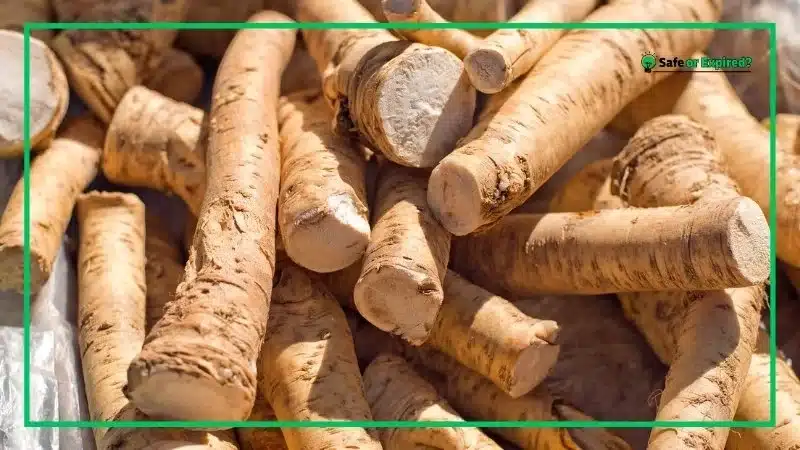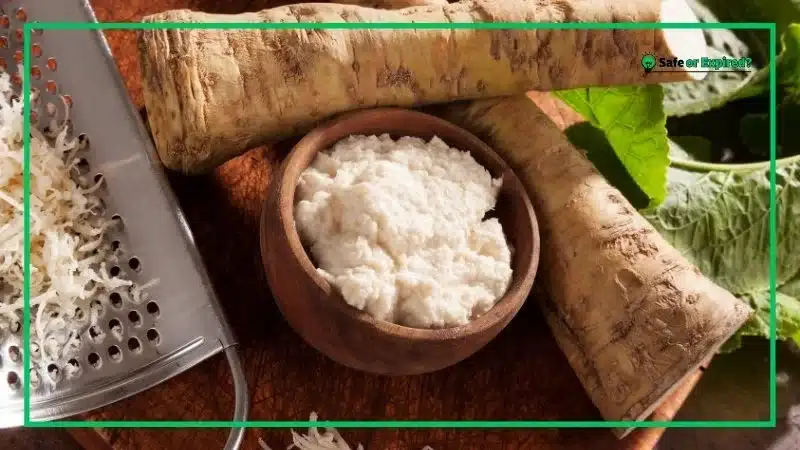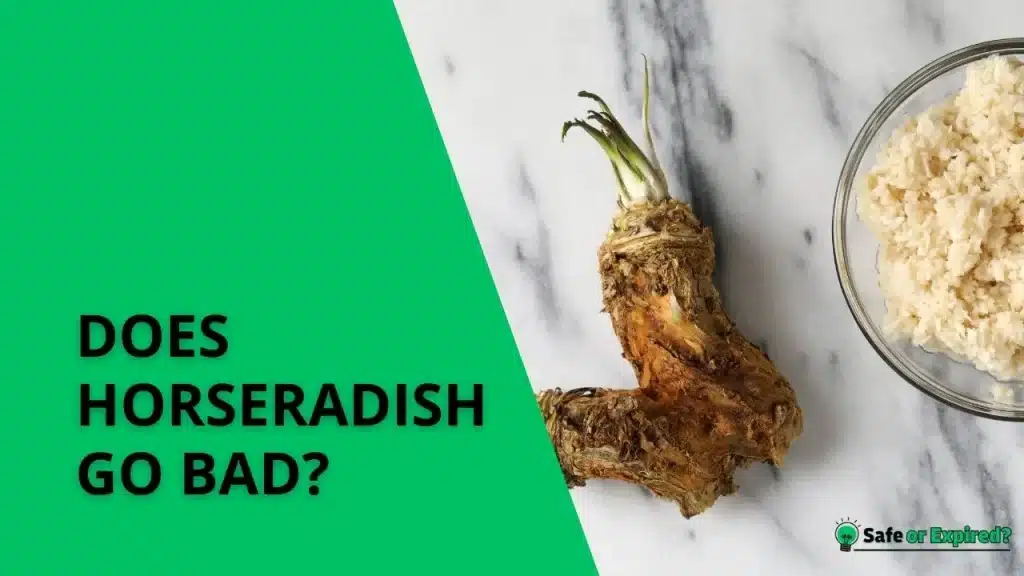Have you ever wondered, “Does horseradish go bad?” If so, then note that it does get spoiled. However, you must be sure how to store this pungent condiment and how long it lasts.
So, continue reading as I guide you through the signs of spoilage and answer your most-asked queries. Let’s begin.
Does Horseradish Go Bad? Explaining the Key Details
Yes, horseradish can go bad, typically remaining fresh for weeks when stored in the refrigerator. If left unrefrigerated, horseradish will deteriorate much faster, often within a few days, due to bacterial growth that affects its safety and quality.
To extend its shelf life, horseradish can be frozen, preserving its quality for up to a year. Always check for spoilage signs, like an off smell or discoloration, before use.
Many people ask the following question: Does horseradish go bad if not refrigerated? Without refrigeration, horseradish quickly deteriorates. If left at room temperature, it will start to lose its potency within a few hours and can become unsafe to consume after a couple of days due to bacterial growth.
You may now want to know, Does horseradish go bad in the refrigerator? In the refrigerator, horseradish maintains its quality for about 4 to 6 weeks. After this period, it may not necessarily spoil but will start to lose its pungency and flavor. It’s best to check for signs of spoilage like an off smell, mold, or unusually soft texture.
So, does horseradish need to be refrigerated? Yes, refrigeration is essential for preserving the quality and safety of horseradish. Keeping it cold slows down the enzymatic reactions and microbial growth that cause spoilage and degradation of flavor and texture.
| Storage Condition | Opened Horseradish | Unopened Horseradish |
| Counter | Not recommended | Not recommended |
| Fridge | 3 to 4 months | 6 to 12 months |
How Long Is Horseradish Sauce Good for After Expiration Date?
Horseradish sauce can remain good for 3 to 4 weeks past its expiration date when stored properly in the refrigerator. The longevity of the sauce after its official expiration can vary based on several factors, including its storage conditions and whether it is homemade or commercially prepared.
Storage Conditions: Keeping Horseradish Sauce Refrigerated is Crucial
Maintaining a consistent, cool temperature is key to preserving horseradish sauce. The optimal storage condition for this condiment is in the refrigerator, typically between 35°F and 40°F. Fluctuations in temperature, such as those that occur with frequent opening of the fridge door or leaving the sauce out at room temperature, can lead to faster degradation of the sauce.
This is due to the acceleration of bacterial growth and enzyme activity that breaks down the sauce’s components, leading to a loss of texture, flavor, and safety.
Preservatives Used: Extending Shelf Life in Commercial Horseradish Sauces
Commercially manufactured horseradish sauces often include preservatives such as sodium benzoate, citric acid, or mustard oil, which help inhibit microbial growth and prolong the shelf life of the product.
These preservatives allow the sauce to remain consumable for a more extended period compared to homemade sauces, which typically lack these additives and are more susceptible to spoilage. Consumers should check ingredient labels for these preservatives to gauge the potential longevity of their horseradish sauce.
Packaging Integrity: Importance of Proper Sealing
The way horseradish sauce is packaged plays a critical role in its shelf life. Containers that are air-tight and well-sealed prevent the ingress of air, moisture, and environmental contaminants. Note that air can lead to oxidation, which not only degrades the quality of the sauce but can also introduce flavors that are stale or off.
Moreover, containers that are frequently opened or not sealed properly after use allow contaminants that can introduce bacteria, leading to spoilage.
Initial Product Quality: Impact on Longevity
The initial quality of horseradish sauce, determined by the freshness and purity of the horseradish root and other ingredients used, significantly impacts how long the sauce remains good past its expiration date.
High-quality ingredients with low levels of initial microbial load can significantly extend the product’s life by delaying the onset of spoilage. Manufacturers achieving this high initial quality often use fresher ingredients and better production practices, ensuring a product that not only lasts longer but also retains better flavor and texture over time.
How Do You Know if Horseradish Is Bad? Signs to Look For
You can tell if horseradish has gone bad by noting changes in its color, smell, and texture. Spoiled horseradish may turn dark, emit a sour odor, and become slimy. These changes indicate that it’s no longer safe to consume and should be discarded to avoid potential health risks.
Color Changes
When fresh, horseradish should have a creamy white to light beige color. If you notice that the horseradish has turned dark or gray, it’s a clear sign that oxidation has occurred, which can compromise both the flavor and safety of the product. Discoloration often precedes other signs of spoilage and is a good initial indicator to check.
Off-Putting Smell
Fresh horseradish has a sharp, pungent scent that is characteristic of its flavor profile. If the horseradish emits a sour or unpleasant odor, it’s a strong indicator of bacterial growth or fermentation that has begun within the product. An altered smell is one of the most noticeable signs that the horseradish is no longer suitable for consumption.
Texture Changes
A good quality horseradish should have a relatively firm texture. If it becomes slimy or overly soft, this is typically a result of bacterial action breaking down the product. This textural change can make the horseradish unappetizing and unsafe for use, as it indicates significant microbial activity which can include harmful bacteria.
Here’s a picture of top-notch horseradish:

How Long Does Creamy Horseradish Last? Let’s Find Out
Creamy horseradish typically lasts for about 3 to 4 months when stored in the refrigerator. This shelf life can be extended slightly if the product remains unopened, but once opened; it should be used within this time frame to ensure the best quality and safety.

Keeping it in a tightly sealed container and refrigerated consistently will help maintain its freshness for the longest possible period. Always check for any spoilage, such as an off smell, discoloration, or change in texture before using.
Can Expired Horseradish Make You Sick?
Yes, consuming expired horseradish can make you sick. If it shows spoilage signs, such as mold, an off odor, or a change in texture, then don’t eat it. It’s because chances are it is harboring harmful bacteria that may lead to foodborne illnesses. It’s essential to inspect horseradish carefully if it’s past the expiration date and discard it if any signs of deterioration are present.
It’s also important to understand what causes food spoilage to effectively prevent it. Explore these factors in “Exploring the Reasons Behind Food Spoilage.”
Can You Use Horseradish Past the Expiration Date?
Yes, you can use horseradish past its expiration date if you don’t see any signs of spoilage. Proper storage and regular checks for freshness can extend its usability beyond the printed date. However, always ensure it smells, looks, and tastes as expected before use to avoid health risks.
Even if the horseradish is past its expiration date but still appears fresh, consider using it in cooked dishes where any potential bacteria can be killed through the cooking process. Always prioritize food safety and quality. Therefore, discard any horseradish if there’s any doubt about its quality, as consuming spoiled food can lead to foodborne illness.
Expired horseradish that has been inspected and shows no signs of spoilage can still be used in various dishes to enhance flavor. Here are some ideas where you can incorporate it safely:
- Sauces and Dressings – Mix it into sauces or dressings for an extra kick. It pairs well with creamy dressings or as a spicy addition to barbecue sauces.
- Marinades – Use horseradish in marinades for meats like beef or pork to add depth and piquancy, helping to tenderize the meat with its enzymes.
- Mashed Potatoes – Stir a little into mashed potatoes for an unusual twist with a mild heat.
- Bloody Marys – A classic addition to Bloody Mary cocktails, providing a sharp, zesty flavor.
- Roast Beef Sandwiches – Spread a thin layer on roast beef sandwiches for an extra burst of flavor.
- Deviled Eggs – Add a bit to your deviled egg mixture to give them a unique and spicy taste.
- Fish Dishes – Horseradish goes well with fish, especially oily fish like salmon, adding a robust flavor contrast.
- Vegetable Dip – Combine with sour cream or yogurt to make a tangy dip for raw vegetables.
These uses are great ways to utilize horseradish that is nearing or has just passed its expiration date, as long as it remains free from spoilage signs. Always ensure it’s safe to consume by checking its appearance, smell, and texture beforehand.
Moreover, note that many myths exist about the best ways to preserve food. Get the facts straight in “Debunking Food Preservation Myths.”
FAQs
Can I Eat Expired Horseradish Sauce?
Yes, expired horseradish sauce can be eaten if it shows no signs of spoilage, such as mold, off odors, or unusual textures. However, it’s crucial to inspect the sauce carefully and ensure it has been stored properly. If in doubt, it’s safer to discard it to avoid potential health risks.
Does Horseradish Mustard Go Bad?
Like any condiment, horseradish mustard can go bad over time, especially if not stored properly. It typically remains good for several months beyond its best-by date if kept refrigerated and tightly sealed. Always check for spoilage signs like mold, unpleasant smells, or changes in texture before using.
How Long Can You Keep an Opened Jar of Horseradish?
An opened jar of horseradish can generally be kept in the refrigerator for about 3 to 4 months. To maximize its shelf life, ensure the jar is tightly closed after each use and store it in the coldest part of your refrigerator.
Does Prepared Horseradish Go Bad in the Refrigerator?
Yes, prepared horseradish can go bad in the refrigerator, typically after 4 to 6 weeks. To extend its freshness, keep it in a tightly sealed container and monitor for any signs of spoilage like darkening, foul smells, or sliminess. If any of these signs are present, it should not be consumed.
Conclusion
Horseradish, like many condiments, can spoil if not stored correctly. Here are the key takeaways to ensure your horseradish remains safe and enjoyable to use:
- Storage is crucial: Keep horseradish refrigerated and tightly sealed to extend its lifespan.
- Check for spoilage: Look for signs like an off smell, discoloration, or sliminess to determine if it’s gone bad.
- Shelf life varies: Freshly prepared horseradish lasts about 4 to 6 weeks in the fridge, while commercially prepared ones can last longer due to preservatives.
- Safety first: Discard any horseradish that shows signs of spoilage to avoid health risks.
Remember, proper care and attention to storage can significantly affect how long your horseradish maintains its quality. Use these tips to enjoy your horseradish at its best for as long as possible.

